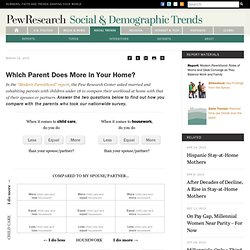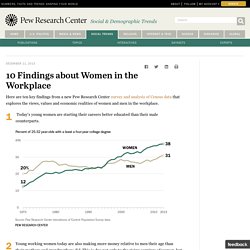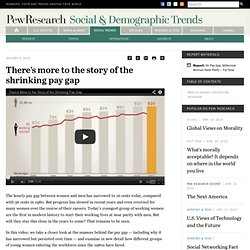

There's More to the Story of the Shrinking Pay Gap. Which parent does more in your home? In the "Modern Parenthood" report, the Pew Research Center asked married and cohabiting parents with children under 18 to compare their workload at home with that of their spouses or partners.

Answer the two questions below to find out how you compare with the parents who took our nationwide survey. When it comes to taking care of your child and household chores and responsibilities, do you do more work, less work or an equal amount of work than your spouse/partner? Choose the one box below that best describes your situation. When it comes to child care, do you do More Equal Less than your spouse/partner? When it comes to housework, do you do Compared to my spouse/partner... ← I do less Child care I do more → ← I do less Housework I do more → All Parents Fathers Mothers Compare yourself with: Select your workload above to compare yourself to the results of the Pew Research survey. * Figures may not add to 100% because "Don't Know," "Refused" and other voluntary responses not shown.
Embed this Graphic: 10 Findings about Women in the Workplace. Here are ten key findings from a new Pew Research Center survey and analysis of Census data that explores the views, values and economic realities of women and men in the workplace. 1 Today’s young women are starting their careers better educated than their male counterparts. 2 Young working women today are also making more money relative to men their age than their mothers and grandmothers did.

There’s more to the story of the shrinking pay gap. The hourly pay gap between women and men has narrowed to 16 cents today, compared with 36 cents in 1980.

But progress has slowed in recent years and even reversed for many women over the course of their careers. Today’s youngest group of working women are the first in modern history to start their working lives at near parity with men. But will they stay this close in the years to come? That remains to be seen. In this video, we take a closer look at the nuances behind the pay gap — including why it has narrowed but persisted over time — and examine in new detail how different groups of young women entering the workforce since the 1980s have fared.
Read the report: On Pay Gap, Millennial Women Near Parity – For Now. On Pay Gap, Millennial Women Near Parity – For Now. Despite Gains, Many See Roadblocks Ahead A new cohort of young women—members of the so-called Millennial generation—has been entering the workforce for the past decade.

At the starting line of their careers, they are better educated than their mothers and grandmothers had been—or than their young male counterparts are now. But when they look ahead, they see roadblocks to their success. They believe that women are paid less than men for doing the same job. They think it’s easier for men to get top executive jobs than it is for women. While the public sees greater workplace equality between men and women now than it did 20 to 30 years ago, most believe more change is needed.
As Millennial women come of age in the “lean in” era they share many of the same views and values about work as their male counterparts. These findings are based on a new Pew Research Center survey of 2,002 adults, including 810 Millennials (adults ages 18 to 32), conducted Oct. 7-27, 2013. Gender, Work and Wages. Ited Nations Global Issues. Women UN support for the rights of women began with the Organization's founding Charter.

Among the purposes of the UN declared in Article 1 of its Charter is “To achieve international co-operation … in promoting and encouraging respect for human rights and for fundamental freedoms for all without distinction as to race, sex, language, or religion.” Within the UN’s first year, the Economic and Social Council established its Commission on the Status of Women, as the principal global policy-making body dedicated exclusively to gender equality and advancement of women.
Among its earliest accomplishments was ensuring gender neutral language in the draft Universal Declaration of Human Rights. As the international feminist movement began to gain momentum during the 1970s, the General Assembly declared 1975 as the International Women’s Year and organized the first World Conference on Women, held in Mexico City. Every Woman Every Child UN Women merges four UN agencies and offices into one.